2024 Tesla Cybertruck Beast Tested: Space Truckin'
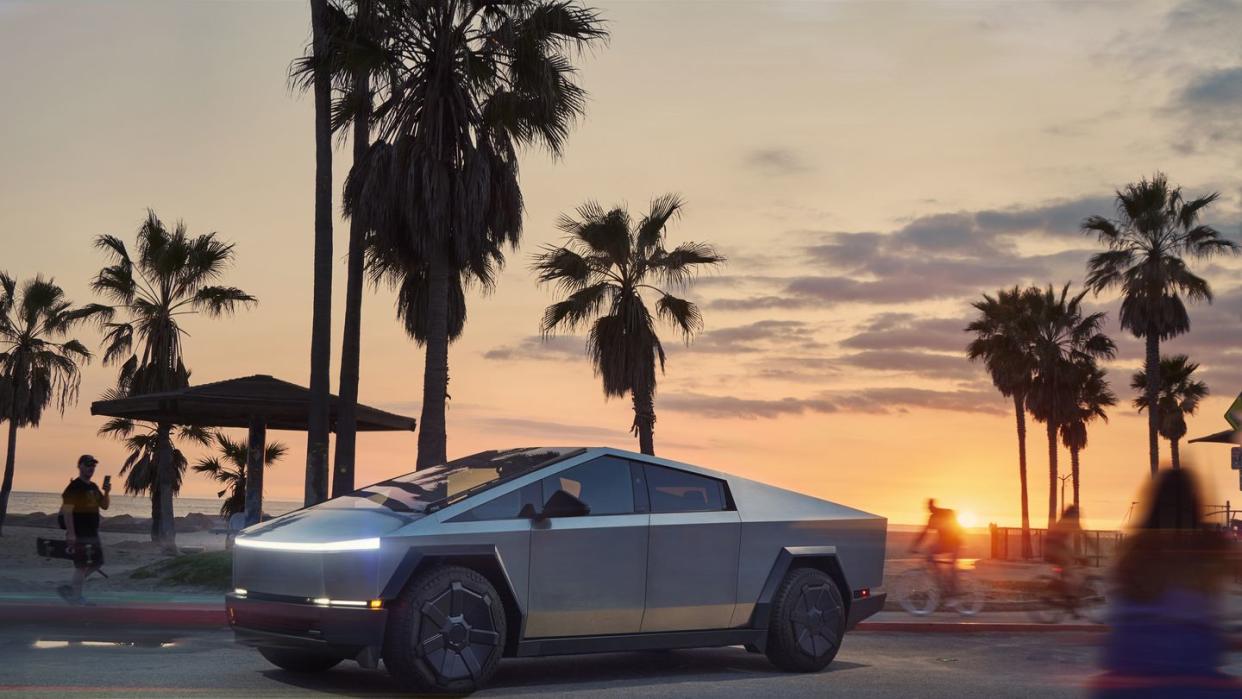
From the May/June issue of Car and Driver.
Is that real? A woman standing next to the 2024 Tesla Cybertruck outside a hotel in Venice, California, is pretty certain she's looking at an escaped movie prop. "Like, is there a car underneath that?" she asks. We inform her that yes, it is real, but if any vehicle will cause you to question objective reality, it's this one. To those of us who are into cars, it seems like the Cybertruck has been around forever—it was announced in November 2019 and has been in the news seemingly every day since. But for a sizable segment of the population, this may as well be an alien lander or an escaped military project. It looks like it drove out of the Home Depot Andromeda in the year 3000 carrying a pallet of nano armor for the ol' fusion recombiner back at the Demogorgon Ranch. When the door opens, you half expect to see the driver's seat occupied by a hologram. The Cybertruck is the craziest production car of the century, and second place isn't even close.
Whether you exclaim "I can't believe they built that!" with a sense of wonder or disdain depends almost entirely on an aesthetic judgment. Either you dig the Cybertruck's 32-bit polygon form factor and naked stainless-steel skin or you don't, and there really is no in between. Driving it around Los Angeles, we need only roll down the windows to get an earful of public sentiment. One guy on a bike rides past and yells, sing-songy, "Cybertruck... lame!" Another says, "I don't know why that gets so much hate. It looks cool." And yet another calls out, "Is that made of wood?" We told you: A significant percentage of the population can't accept that a real car company actually built this to sell to the general public. We're still grappling with that ourselves.
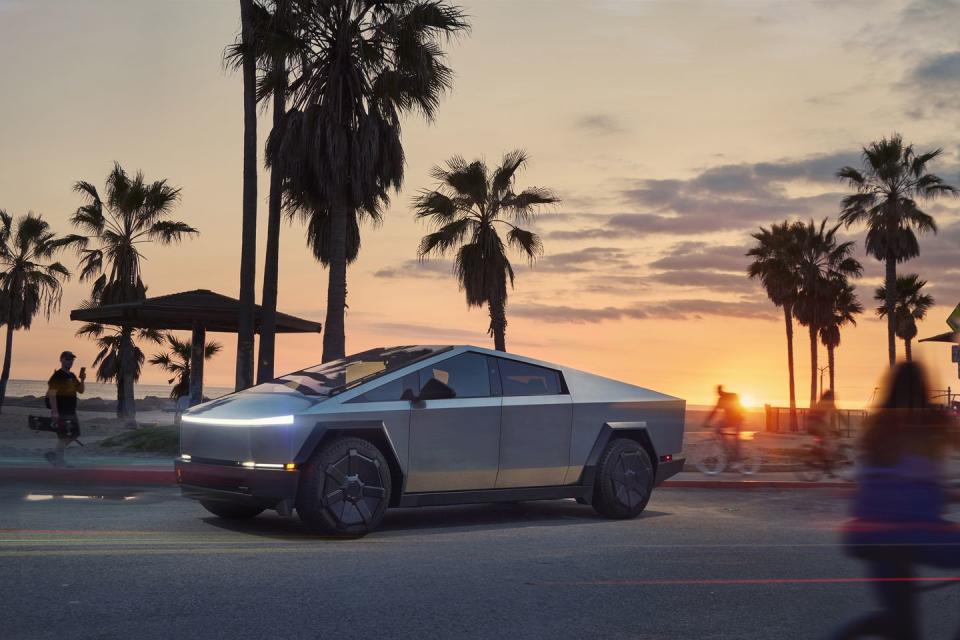
Consider that this tri-motor Beast model—or Cyberbeast, if you will—is a 6901-pound electric pickup truck that can tow 11,000 pounds and also hits 60 mph in 2.6 seconds, which matches the time we recorded with the Lamborghini Huracán STO. It has steer-by-wire and brake-by-wire, and its low-voltage architecture gets bumped up to 48 volts from the typical 12. The truck's numerous sensors and controllers communicate over an internal "etherloop" network, which Tesla claims dramatically reduces the amount of wiring needed for communication among the various subsystems in the vehicle. The power tonneau cover for the bed is lockable and strong enough to stand on. And then there's that dent-resistant stainless-steel skin, which is so robust that the doors have no internal side- impact beams because they don't need them. The Cybertruck represents a thorough rethinking of how to build a car—much of it self-imposed, but progress can come in strange forms.
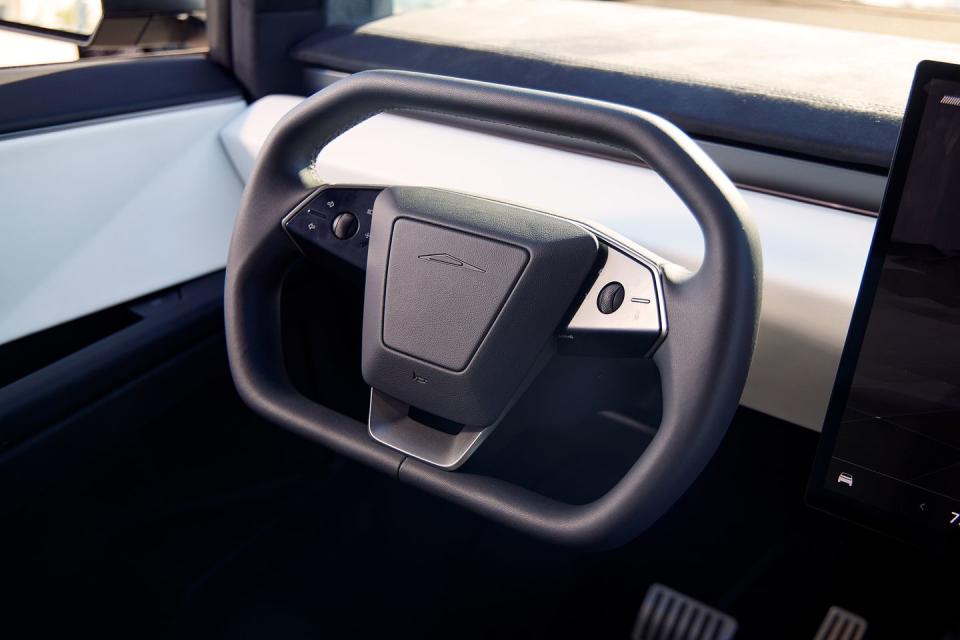
Now Steer This
The Cybertruck's steer-by-wire system lacks a connection between the wheels and the steering wheel, or the cutely named "squircle." While this will surely trigger the foil-hat community, Cybertrucks are safe. Triple redundancy and a diversity of information ensure any fault in the system will not result in a 737 Max situation where the car will not do the driver's bidding.
The front steering rack has two 48-volt motors. Each of those motors reports to two different circuits and is tied to two different controllers. Three feedback sensors (one for each motor and a third for the squircle's motor) report to different controllers. Should one motor fail, there is still enough torque in reserve to steer through a parking lot (where steering forces are greatest).
If one sensor disagrees with the other two, it's ignored. But if the split jury persists, you will get a warning to pull over and call for a tow, because something isn't working properly. You will also get a message to pull over if a controller goes down. If a request to stop safely goes ignored too long, it will eventually brick the truck. —K.C. COLWELL
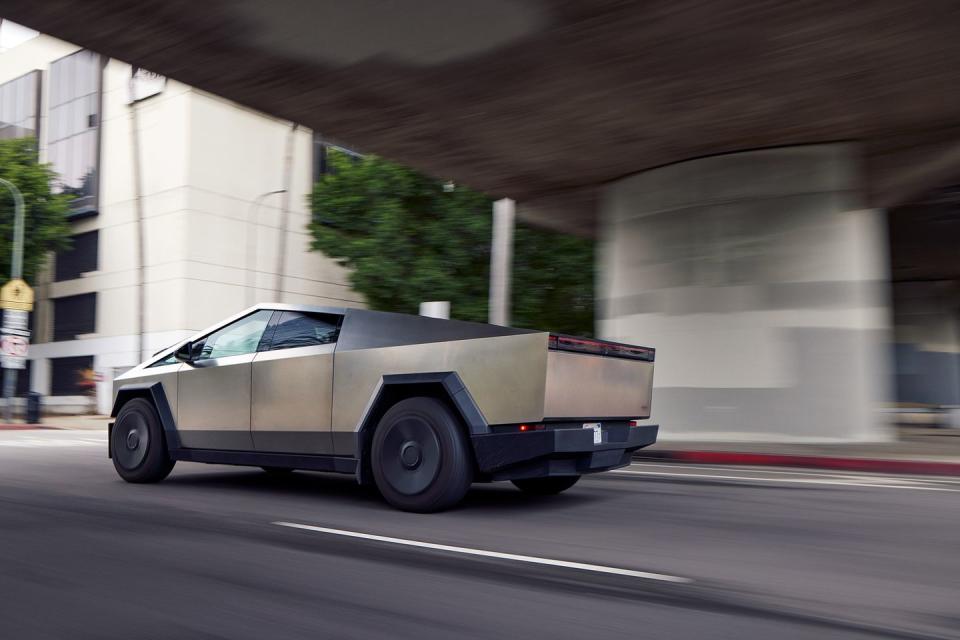
For instance, that steer-by-wire system is essentially a byproduct of Tesla's determination that yokes are cooler than steering wheels, which means you absolutely need a variable steering ratio to avoid multiple hand-over-hand turns. (The Cybertruck's tiller is rectangular, essentially a yoke with a top bar.) While variable-ratio steering can be accomplished mechanically, no mechanism can deliver this truck's level of variability while maintaining 0.9 turn lock to lock. And so the uninitiated inevitably pull away in the Cybertruck tracing a spaghetti path because it's easy to apply too much steering input. Your brain quickly adapts to the new normal, your hands quiet down because you don't need to issue small corrections to follow a straight line. The rear-axle steering also plays a role, enhancing agility to the point that the Beast's dual rear motors don't do any torque vectoring across the axle because the truck is already nimble enough. At one intersection, we had to wait for the Ford F-250 ahead of us to execute a two-point U-turn that the Tesla dispatched in a single arc.
If you're worried about steer-by-wire with no mechanical backup, the backup is basically more steer-by-wire. There are two steering motors, each of which uses a separate controller and power supply, with various sensors on each to sniff out any issues. If one of the motors fails, the truck will go into a limp mode with a five-minute countdown to pull over. The "loop" part of the etherloop points to more redundancy since the truck can lose any component on its network and reroute communication to keep all other systems online. Even the electronically controlled dampers were designed with the what-if of failure in mind. If the dampers lose power, they default to firm valving, so a driver towing or hauling a heavy load won't be stuck with a wallowing truck.
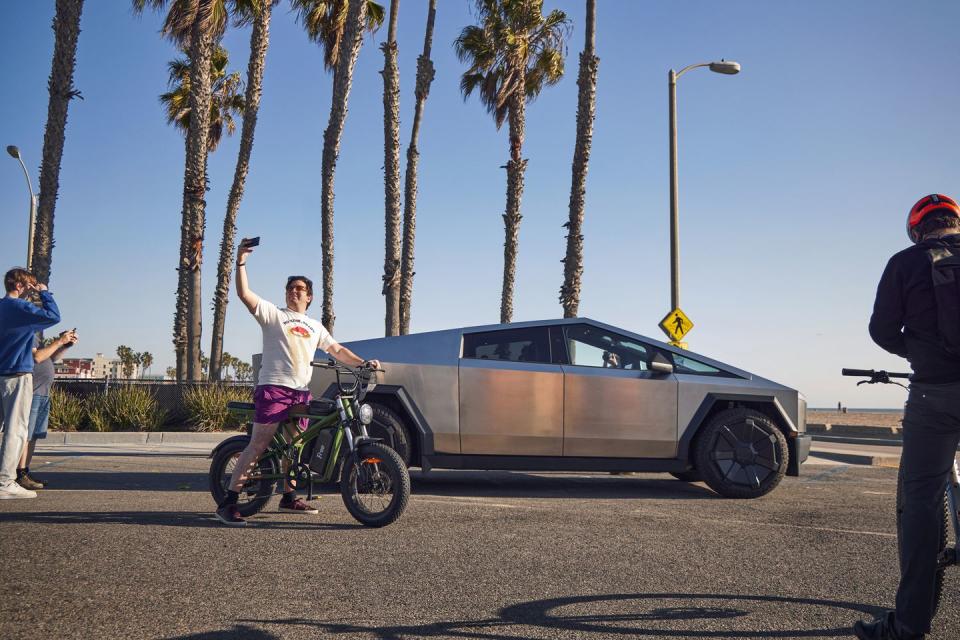
Tesla's thinking on worst-case scenarios and their aftermath extended to crashes too. Thanks to the Cybertruck's snub nose, there isn't as much crush space as you'd enjoy with a traditional long-hood pickup. For the first time, Tesla incorporated collapsible crush tubes into the single, giant front casting that dissipates energy by essentially exploding into tiny pieces. But a crash doesn't mean the entire casting has to be replaced—it can be reconstructed ahead of the intact parts. As for the stainless-steel body itself, it's ready to take on the worst that rogue shopping carts can dish out in the Ralphs parking lot.
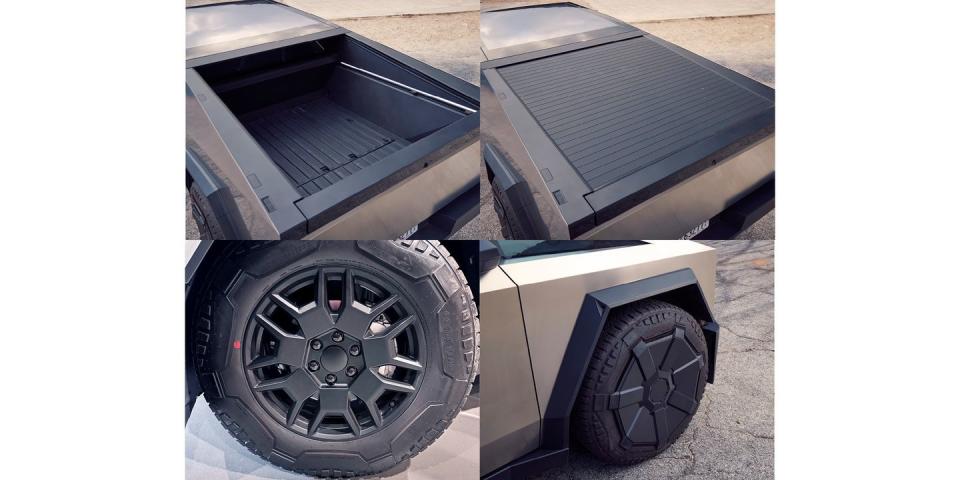
Air Bender
Weirdly, the Tesla Cybertruck has more aero than you might imagine. The front end was always going to be a challenge, but Tesla changed the prototype's flat nose to a subtly curved front panel that helps air bend around the forward flanks. Carefully shaped front flares create a small, deliberate vortex that encourages the flow to bend smoothly around the corners. The prominent wiper acts like a fence that directs air over the top instead of allowing it to swirl down onto the driver's window, cutting down on wind noise. Underneath, the belly is much smoother than any ladder-framed truck could ever hope to be.
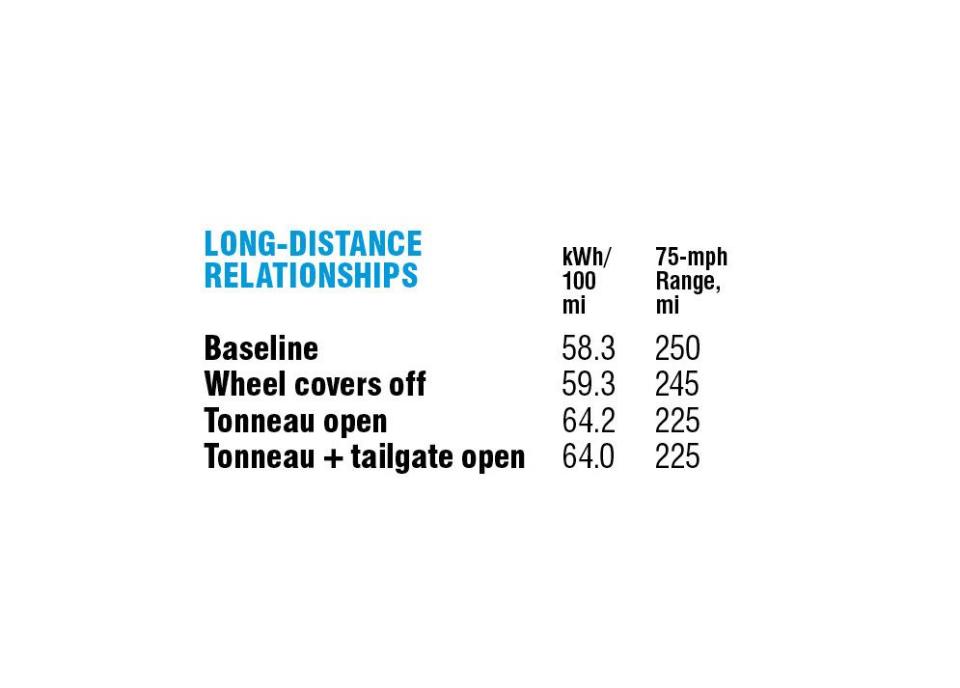
The most surprising aspect may well be how naturally well suited the angular-looking aft end is. The rearmost flanks taper gently like some kind of teardrop, which is the most inherently aerodynamic shape. The abrupt truncation at the tailgate is actually quite good aerodynamically, with the air flowing over and off the body smoothly, thereby reducing drag more than a rounded tail might achieve.
The roll-top tonneau is essential to all of this, of course, so we conducted 75-mph steady-state tests with it closed and open, as well as with both it and the tailgate open to create an exit for the air "trapped" in the bed. We also wondered about the effect of the wheel caps, so we repeated our tonneau-closed runs with those off as well. The 10-percent hit to consumption the open tailgate generates is less surprising than the barely 2-percent loss without the wheel covers. But Tesla warned us that the covers are largely aesthetic. —DAN EDMUNDS
About those panels: Tesla formulated its stainless-steel alloy to prioritize hardness and corrosion resistance. Much has already been made of Cybertrucks wearing grimy orange rust stains, which result when iron particles in the air alight on the truck and begin oxidizing. You can wipe them off (we used an ammonia-free glass cleaner), but the Cybertruck definitely makes you acutely aware of how much airborne iron is apparently floating around out there. You can also give it a good scouring with Bar Keepers Friend, after which the metal will "repassivate," forming its own protective haze. Since this consumes maybe a few microns of metal thickness, you could theoretically clean a hole in your truck, but with 1.8-mm-thick door panels, that would take a lot of scrubbing. One thing that Tesla says won't put a hole in your door: subsonic ammunition. We did not test that claim, as our accountants strongly discourage the shooting up of six-figure trucks.
The Secret Sauce
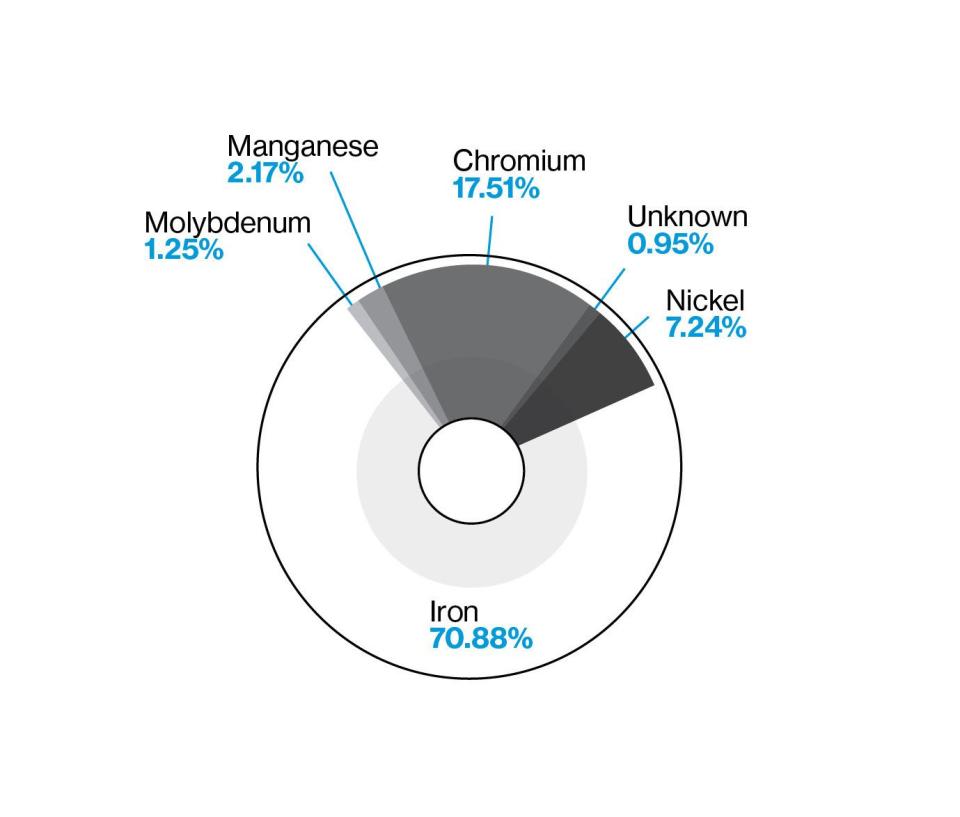
Tesla hasn't specified the Cybertruck body's alloy formulation, but metal recyclers make it their business to know exactly what they're paying for. At C&M Metals in Los Angeles, co-owner Todd Monroe pointed his XRF spectrometer at the Tesla's front end and got immediate confirmation that this is, metallurgically speaking, good stuff—sort of like a 301 or 303 alloy but not exactly either one.
"It’s got a lot of nickel, a lot of chromium. This is what you'd call an industrial stainless steel," Monroe said. Okay, so what's the bottom line? "I'd give you 50 cents a pound for it."
Indeed, this Beast Foundation Series model checked in with a $121,985 retail price. That's about as much as you can spend on a Cybertruck and nets the 834-hp tri-motor configuration—two at the rear, one at the front. Dual-motor versions with 593 horsepower start at $81,985; next year, a rear-drive Cybertruck is promised with a starting price of $62,985. The Foundation Series, a $20,000 upcharge, gets Tesla's promised Full Self-Driving capability, and all Beasts have an electronic locking front differential—neither was enabled on this early-build truck, though. (Dual-motor trucks get a locking diff at the rear too, but the Cyberbeast's dual rear motors eliminate that need.) After so many years of anticipation, Tesla apparently decided just to start building trucks and push updates later.
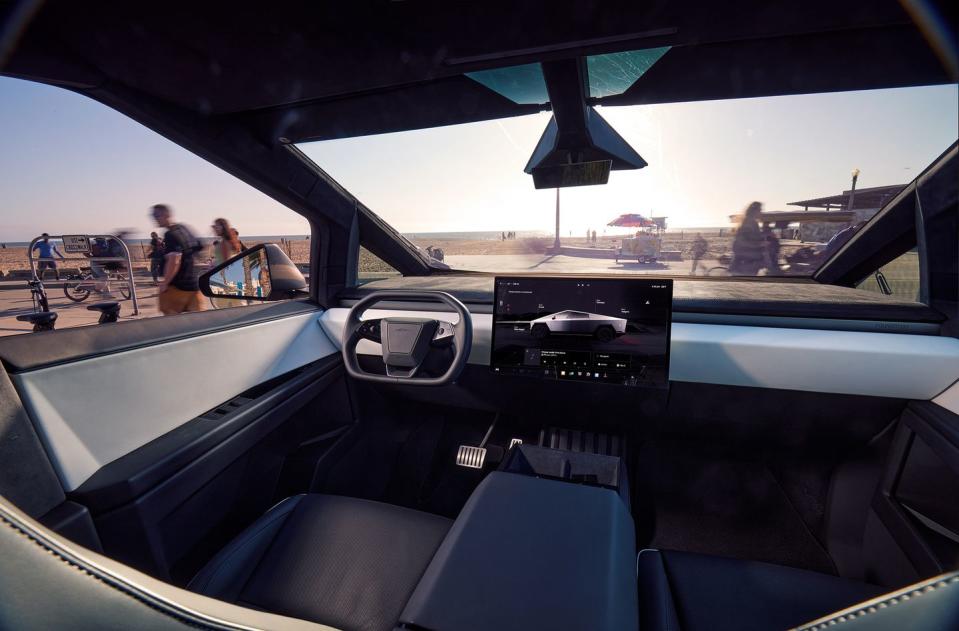
For now, there are some grayed-out options on the dash-dominating touchscreen, which controls nearly every function on the truck. (A few primary controls, like the turn signals and the windshield-wiper button, are on the steering yoke.) The screen works well, given the multifarious tasks assigned to it. Among them is a rearview-mirror function, since the deployed tonneau cover completely blocks the rear window. Video rearview mirrors usually make us want to barf, but this one doesn't, perhaps because it can take up about a quarter of the 18.5-inch screen and doesn't require intense scrutiny. The touchscreen is also your means of selecting drive modes and ride heights from the air springs, which can lower the truck for ingress and egress or give it 16.0 inches of ground clearance in the off-road Extract mode. There's still some tuning to be done there too—the truck automatically lowers when you open a door, which Tesla belatedly realized is not the hot ticket if you're off-roading.
Beast mode is aptly named. Besides that scorching 2.6-second 60-mph time—accompanied by tortured howls off the line from all four Goodyear Wrangler Territory RT all-terrain tires—the Cybertruck cleared the quarter-mile in 11.0 seconds at 119 mph. We saw a top speed of 131 mph, and the truck felt completely stable at Vmax. Tesla claims that the truck generates some rear downforce, a pickup-truck stat as unusual as its 0.34 coefficient of drag. That figure is aided by a flat underbody, which is a big reason the Cybertruck doesn't carry a spare tire there; an available one mounts in the bed. We'd bet Tesla could have figured out how to stash a spare—there's an underbed trunk area near the tailgate, Honda Ridgeline style—but maybe that was one engineering challenge too many. We get the impression that the powder-coated aluminum tonneau cover alone caused some sleepless nights after it was rolled up and down 10,000 times. With sand in the mechanism.
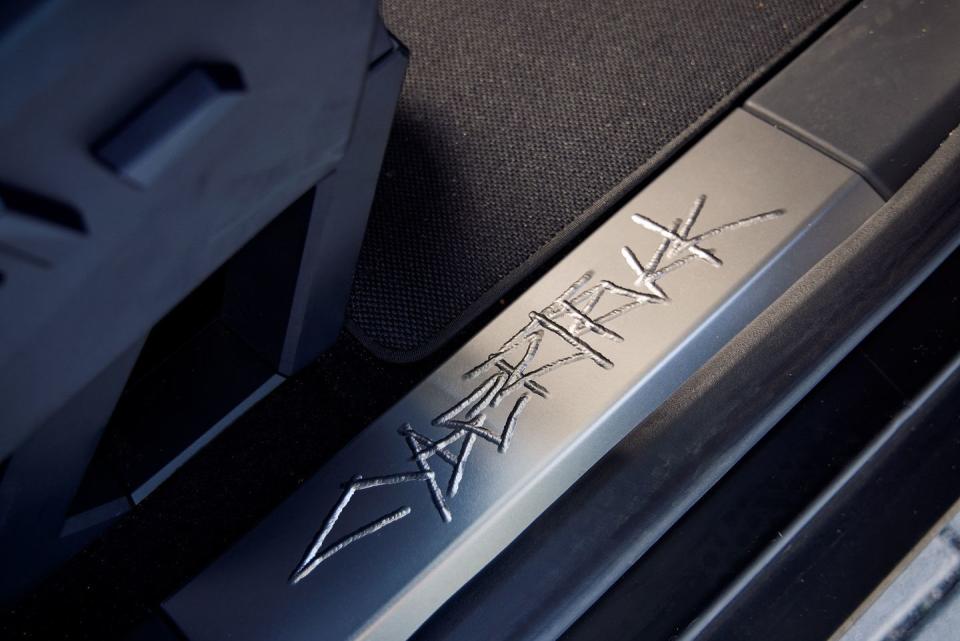
The Cyberbeast's skidpad figure—0.75 g—is decidedly more trucklike than its straight-line performance and not surprising given the weight and all-terrain rubber. In fact, maybe it's surprising that it's that high. Thanks to the Beast's gross vehicle weight rating of 9169 pounds, it is technically a heavy-duty truck, a class that doesn't typically post superlative skidpad numbers.
Heavy-duty trucks also don't require EPA range numbers, but Tesla decided to roughly follow the light-duty EPA methodology anyway. We found Tesla's numbers to be in line with the performance of other electric trucks, which is to say our 75-mph highway test nets a lower-than-claimed range. Tesla pegs the Beast's range with the all-terrain tires at 301 miles, while we saw 250 miles in our 75-mph test. That's better than a Ford F-150 Lightning Platinum (230 miles) did in our test but not as good as the quad-motor Rivian R1T on all-terrains (250 miles) and a dual-motor R1T Performance (280 miles) or the GMC Hummer EV Edition 1 Pickup (290 miles). Tesla claims up to 340 miles of range for the 593-hp dual-motor Cybertruck. If you want to use some of that 123.0-kWh battery capacity to run your house, the Cybertruck is the first Tesla that can power-share through its charge port to provide 11.5 kilowatts of backup power, while the four 120-volt and single 240-volt outlets in the truck can provide a maximum of 9.6 kilowatts.
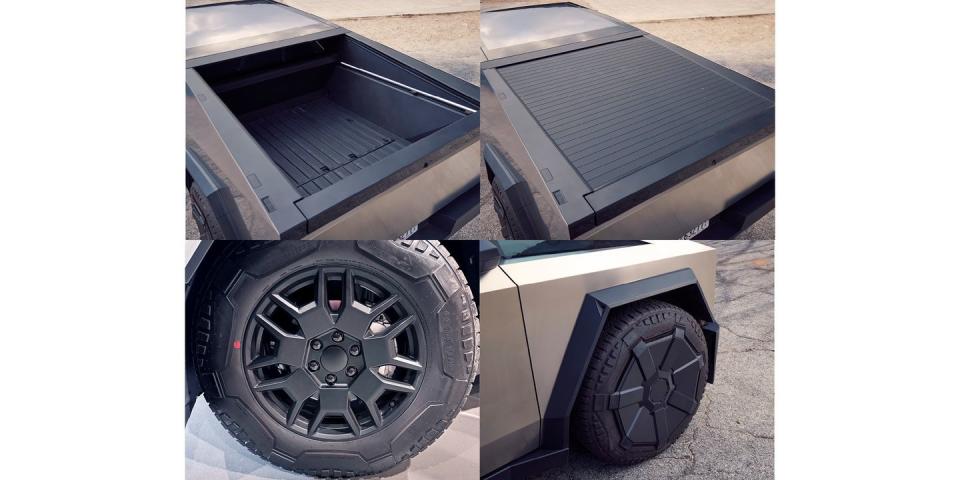
The Prong Way
The wheel-cover prongs are meant to align with indents in the tire sidewalls. They are two-piece caps that can be rotated slightly relative to the wheel to get the correct alignment. But tires aren't consistently lined up when mounted, and even if they were, they can slip under hard braking or acceleration. Because the covers have to be aligned with the tire rather than the wheel, and the tires don't automatically index to the wheels, there's no single spot to put the air valve access hole, so there isn't one. The covers have to be removed to access the valve. Thankfully, tire pressures are displayed on the touchscreen.
Ultimately, the Cybertruck is a practical machine in an improbable wrapper. It's the quickest truck we've ever tested, yes, but compared with existing electric trucks, it mostly represents a difference in degree rather than kind. Its 11,000-pound towing capacity is about what you'd expect, and so is its range. The Cybertruck is chock full of clever and original engineering, but, again, most of it is directed toward solving problems Tesla created for itself. Like, the 48-volt electrics allow a relatively small motor to drive that huge windshield wiper, but you could also just not have a single huge windshield wiper (which incidentally works better as an aerodynamic aid than as a wiper; at highway speeds, it shifts two degrees downward from vertical to reduce drag by 1 percent). Steer-by-wire is novel, but millions of cars cruise around just fine with a mechanical steering column. And dent-resistant body panels are nifty, but Saturns didn't require a stockpile of Bar Keepers Friend.
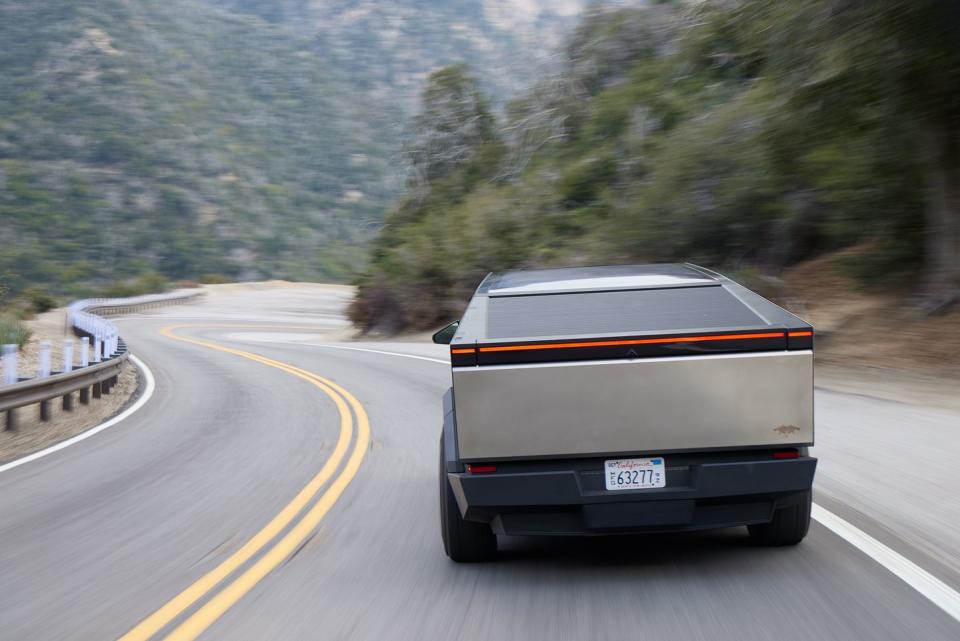
The good news is that the learnings from the Cybertruck will inevitably migrate to other Teslas, perhaps those with a more wide-spread audience. Because as much as we love weird machines, and as much as Tesla die-hards regard the Cybertruck as the inevitable template for all future pickups, it's hard to see it becoming a mainstream hit. Even some reservation holders we met were lukewarm upon finally seeing it in the gleaming metal. One woman said, "Am I still going to want this in four years or whenever my reservation comes up? It's losing its luster for me. I mean, $100,000—I could buy a boat." In other words, another purchase that's more discretionary than necessary.
To want a Cybertruck, you have to love the brand of attention that the Cybertruck brings and be willing to live with that, even once it becomes a seminormal sight on American roads. The Cybertruck requires full commitment to "JK, LOL" as an all-encompassing aesthetic and worldview, on a level that obviates anything going on under the skin—nobody is saying, "I hate the way this machine looks, but I really love 48-volt electrical systems and steer-by-wire, so I'm gonna buy one." Not everybody wants to drive a piece of rolling performance art, but those who do will be happy to find that they've also got a really good truck.
Counterpoint
I was expecting to despise the Cybertruck, but this best-riding Tesla has earned my respect now that I've spent a weekend behind the wheel—or "squircle," as they call it, but it's really a yoke with a crossbar. You'll never reposition your hands as you sling it from full left to full right lock, which isn't even a complete turn. This sounds potentially hairy at speed, but it isn't. The variable ratio is velocity dependent, and response feels appropriate and predictable however fast you're going. I got used to it in the parking lot, and it felt second nature well before I merged onto the freeway. The weird part happened when I got back into my own car, whose steering felt ungodly slow as I pulled out of my driveway. In minutes, decades of steering history felt ancient. I am changed. —DAN EDMUNDS
Time will tell how gracefully the Cybertruck ages, though the odds don't look promising. But unless you have a deposit down, it really doesn't matter whether you love the drafting- triangle design or hate it enough to kick it no matter how much it hurts your foot (speaking from personal experience). It's far easier to respect the transparent amount of innovation required to overcome the design-imposed challenges. And what's more impressive isn't that this radical rethink works as well as it does despite the way the Cybertruck looks; it's that Tesla, in its first foray into a well-established and highly competitive segment, has accomplished all of this on a new platform. That fact should elevate our expectations for other American-made pickup trucks. —CARLOS LAGO
You Might Also Like

